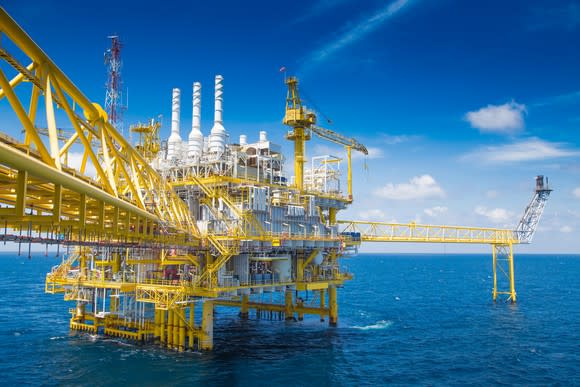If I Had to Buy One Stock in May, It Would Be This One
I've written previously about my belief that shrinking oil inventories and rising crude oil prices will spark a recovery in energy services stocks, and I've already explained why Core Labs and Hess Corp are favorite stocks of mine to buy. Now, after reviewing Oceaneering International's (NYSE: OII) first-quarter results, I'm increasingly convinced that it's a great time to add this stock to any portfolio.
Demand for its remotely operated vehicles (ROV) and subsea products are tightly tied to offshore exploration and production activity. If I'm right, a recovery in deepwater drilling because of higher oil prices will result in greater utilization of its fleet, improving contract rates, and increased sales of underwater products.
What's the business
The company breaks its business into two segments: oilfield and advanced technologies. The former helps oil and gas companies with offshore projects, and the latter serves non-energy industries, such as the military.

Image source: Getty Images.
Within the oilfield segment, it operates four business units: ROVs, subsea products, subsea projects, and asset integrity.
Tethered submersible vehicles that are operated remotely from the surface, ROVs are used by oilfield companies to install subsea hardware, inspect pipes and facilities, and for maintenance and repair jobs. Oceaneering International's fleet consists of 279 of these vehicles.
The subsea products business manufactures products including production control umbilicals, which are used by offshore companies to control subsea wellhead flow rates, monitor downhole and wellhead conditions, and to provide power and fluids to other subsea processing hardware, including pumps.
Its subsea projects business provides management solutions for installations, inspection, maintenance, and repair using two vessels it owns and other vessels it charters. This business unit works in the Gulf of Mexico, Angola, and India.
The asset integrity division helps oil and gas, power generation, and petrochemicals at onshore and offshore facilities maintain their infrastructure. The advanced technologies business primarily makes its money by helping the U.S. Department of Defense with solutions for the U.S. Navy.
What's going on
To understand why I think Oceaneering International is a buy, it helps to understand just how horrendous the market has been for its oilfield business over the past few years. As you can see in the following table, revenue from its three largest oilfield businesses has declined massively since crude oil prices peaked in 2014
Major Business Units (Millions) | 2017 | 2016 | 2015 |
|---|---|---|---|
ROVs | $394,655 | $522,121 | $807,723 |
Subsea products | $625,513 | $692,030 | $959,714 |
Subsea projects | $291,933 | $472,979 | $604,484 |
Data source: Oceaneering International.
The slowdown in these segments has more than offset an increase in advanced technologies revenue, rising from $318 million in 2015 to $374 million in 2017. Unfortunately, that trend continued in the first quarter of 2018.
In Q1, Oceaneering International's ROV sales fell to $86 million from $94 million a year ago; subsea products sales fell to $127 million from $151 million last year; and its subsea projects sales fell to $57 million from $63 million. Those declines dwarfed the $82,000 year-over-year increase in advanced technologies sales to $86 million.
In discussing the oilfield segment's lackluster first-quarter performance, management cited a couple challenges: a drop in revenue per days on hire in ROVs and a decline in subsea products backlog to $240 million from $276 million between Q4 2017 and Q1. The backlog decline was due to an anemic 0.71 book-to-bill ratio, or new orders divided by filled orders.
Suffice it to say, those weren't encouraging disclosures; however, management did make some comments that give me reason to think a turnaround is coming.
Specifically, the utilization of its ROV fleet ticked up 2% in the quarter to 44%, and while that's not enough of a bounce to cause contract rates to rebound, it's positive momentum that management expects to continue. For the full year, the company is guiding for fleet utilization into the low 50% range and ROV drill support market share of 60%, up from 58% in Q1.
Management also expects an improvement in its subsea products business in the second half of 2018. Although it still has a lackluster outlook for Q2, management thinks that increasing offshore activity and contract awards later this year will result in subsea products book-to-bill ratio climbing back above 1.0. A seasonal pick up in the Gulf of Mexico should provide some support to the company's subsea projects business too.

Image source: Getty Images.
Why I like this stock
According to the International Energy Agency (IEA), global supply and demand for oil should be largely in balance by 2019. Despite significant increases in U.S. shale production, crimped production in the Middle East and global economic growth has reduced oil storage levels back toward their five-year averages. As supply falls more into balance with energy demand, it's putting a floor beneath oil prices that's making exploration and production (E&P) companies more interested in spending money on new projects.
About 3 million barrels of oil per day in production are lost because of maturing oil fields, and cuts to capital spending budgets since 2014 have put oil and gas producers behind the curve when it comes to replacing those lost barrels. As profitability improves for these companies, it wouldn't surprise me if capital spending budgets increase substantially from current levels to play catch-up.
Adding conviction to this thinking is the latest capital spending forecast from ExxonMobil. After years of declining investment, ExxonMobil plans to spend $24 billion on capital projects in 2018, $28 billion in 2019, and then it plans on spending an average of $30 billion per year on projects between 2023 and 2025. Admittedly, most of its spending increases will go to land-based projects, however, some will head offshore Guyana, where ExxonMobil hopes to tap 6.6 million acres for up to 500,000 barrels of oil production per day in the future.
It remains to be seen if other big players, such as BP, will similarly increase their budgets from here, but it's possible. An increase by BP would be particularly good news for Oceaneering International because it has historically been Oceaneering International's biggest customer. For example, it accounted for 18% and 12% of Oceaneering International's revenue in 2016 and 2017, respectively. So far, BP's keeping a lid on its budget, but it has a few intriguing offshore plays, including Clair Ridge, that if successful, could allow it to bump up its spending.
Patience is key
I don't expect that an increase in offshore spending will translate into Oceaneering International's contract rates spiking overnight, but if offshore capital expenditures do bottom this year, then contract rates may start to slowly improve. If so, then Oceaneering International's stock price could have a lot of room to run higher over the next few years because, in the past, it has had significant operating leverage. For perspective, the company's peak operating margin and net income during the last offshore spending boom was significantly above where we are today.
OII Operating Margin (TTM) data by YCharts.
Overall, as long as the rally in oil and gas commodity prices makes offshore projects financially attractive, demand for Oceaneering International's ROVs and subsea products should pick up. Anything could happen in the short term, but I think the odds are in its favor, and for that reason, it's my top stock to buy this month.
More From The Motley Fool
Todd Campbell has no position in any of the stocks mentioned. His clients may have positions in the companies mentioned. The Motley Fool recommends Core Laboratories and Oceaneering International. The Motley Fool has a disclosure policy.

 Yahoo Finance
Yahoo Finance 
